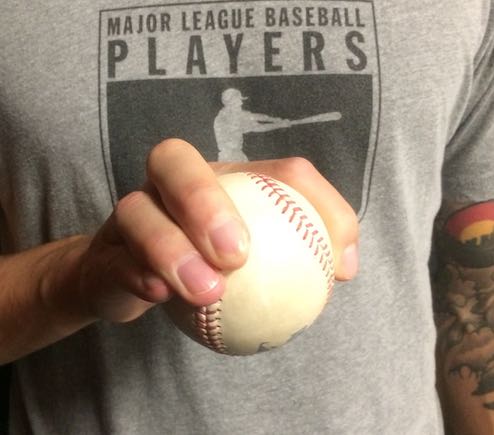These are notes on prospects from lead prospect analyst Eric Longenhagen. Read previous installments here.
Patrick Sandoval, LHP, Los Angeles Angels
Level: Double-A Age: 22 Org Rank: 16 FV: 40
Line: 5 IP, 4 H, 2 BB, 0 R, 9 K
Notes
Acquired from Houston in exchange for Martin Maldonado last summer, Sandoval now has 45 strikeouts in 28.2 career innings at Double-A. He continues to work with middling fastball velocity but some mechanical elements help it to play better than 90-94. Houston got Sandoval to open his front side a little more, tilt his spine, and release the ball with a more vertical arm slot than he was using in high school. It’s a weirder look for hitters and creates more backspin and, therefore, more “rise” on his fastball. Sandoval also works heavily off his two secondary pitches, and his changeup may be better than we currently have it projected to be on The Board. The strike-throwing is still inconsistent start to start, but Sandoval is officially having upper-level success for a franchise that keeps having injury issues on the big league roster, so perhaps he should be included in the Canning/Suarez/Barria group of young hurlers who may help the Angels sooner than later.
Nate Pearson, RHP, Toronto Blue Jays
Level: Hi-A Age: 22 Org Rank: 4 FV: 50
Line: 5 IP, 1 H, 0 BB, 0 R, 9 K
Notes
Pearson was removed from his previous start after just 27 pitches, so it was a relief to see him back and dominant five days later. Pearson’s future as a strike-thrower is hard to anticipate. He was wild last fall but he hadn’t pitched all year due to a fractured ulna, so that wildness could have just been due to rust. He threw 43 of 59 pitches for strikes yesterday, a sign he may actually be able to harness his alien stuff and find a way to start long-term. He may be on an innings limit this year, so unless the Jays expertly manicure his workload with a big league goal in mind (perhaps that two-inning outing last start is an indication of how they’ll handle Pearson throughout the year) it’s unlikely we see him in the big leagues until next year at least. It’s still too early to reposition Pearson in our rankings due to increased confidence that he’ll start, but yesterday’s outing, during which he sat 94-98 and touched 102, could soon be part of a body of evidence indicating we should.
Anderson Tejeda, SS, Texas Rangers
Level: Hi-A Age: 20 Org Rank: 4 FV: 45+
Line: 2-for-5, 2 HR
Notes
These were Tejeda’s first two homers of the year. He’s back at Hi-A despite having success there last year, presumably so the Rangers can let Michael De Leon (who peaked as a teenager) get regular at-bats at Frisco for the third consecutive year. Tejeda is off to a strong start, and may force a promotion to Double-A (and into our Top 100) if he keeps it up for another few weeks.
Ljay Newsome, RHP, Seattle Mariners
Level: Hi-A Age: 22 Org Rank: NR FV: 35
Line: 6.2, 4 H, 0 BB, 0 R, 10 K
Notes
We touch base on players like Newsome when we write the org lists. He threw a lot of innings last year and he barely walked anyone, so we checked on the stuff to see if it cleared the bar to stick someone on the list at all. With Newsome, that had not been true. Despite all the strikes, his fastball has been in the mid-to-upper 80s basically since high school, and those guys typically max out as spot starters. Now, Newsome is different. He took part in an offseason velo program and now resides in the 91-94 mph range. He’s clearing his front side a little more, his two-seamer has more tail, he’s working up in the zone with his four-seamer more often, and is setting up his changeup better. Take the performance of a 22-year-old repeating Hi-A with a grain of salt, but know Newsome has grown and changed, and is off to a strong start.
A Weird Box Score
Tulsa pitchers combined to no-hit Arkansas into extra-innings last night, but still lost due to a slew of walks in the 10th inning. The Arkansas staff allowed five hits, but fewer total baserunners than Tulsa did, so in my opinion, justice was done.
Weekend Notes
I saw mostly amateur stuff over the weekend, as both Adley Rutchsmann and Andrew Vaughn (the top two prospects on our Draft Board) were in the state of Arizona. Neither did anything to merit a move in our rankings. The only surprising moment of my weekend was seeing a person in a Detroit Tigers polo operating an Edgertronic camera. To this point, I had only seen Houston employees training cameras like that on hitters.
We’ve begun experimenting with high speed video and while some of its applications (beyond just looking cool) are obvious, especially as it relates to pitching (who is spin efficient, who is not, ah, there’s also a two-seamer, etc), we’re curious if there are applications on the hitting side beyond just breaking down mechanics.

